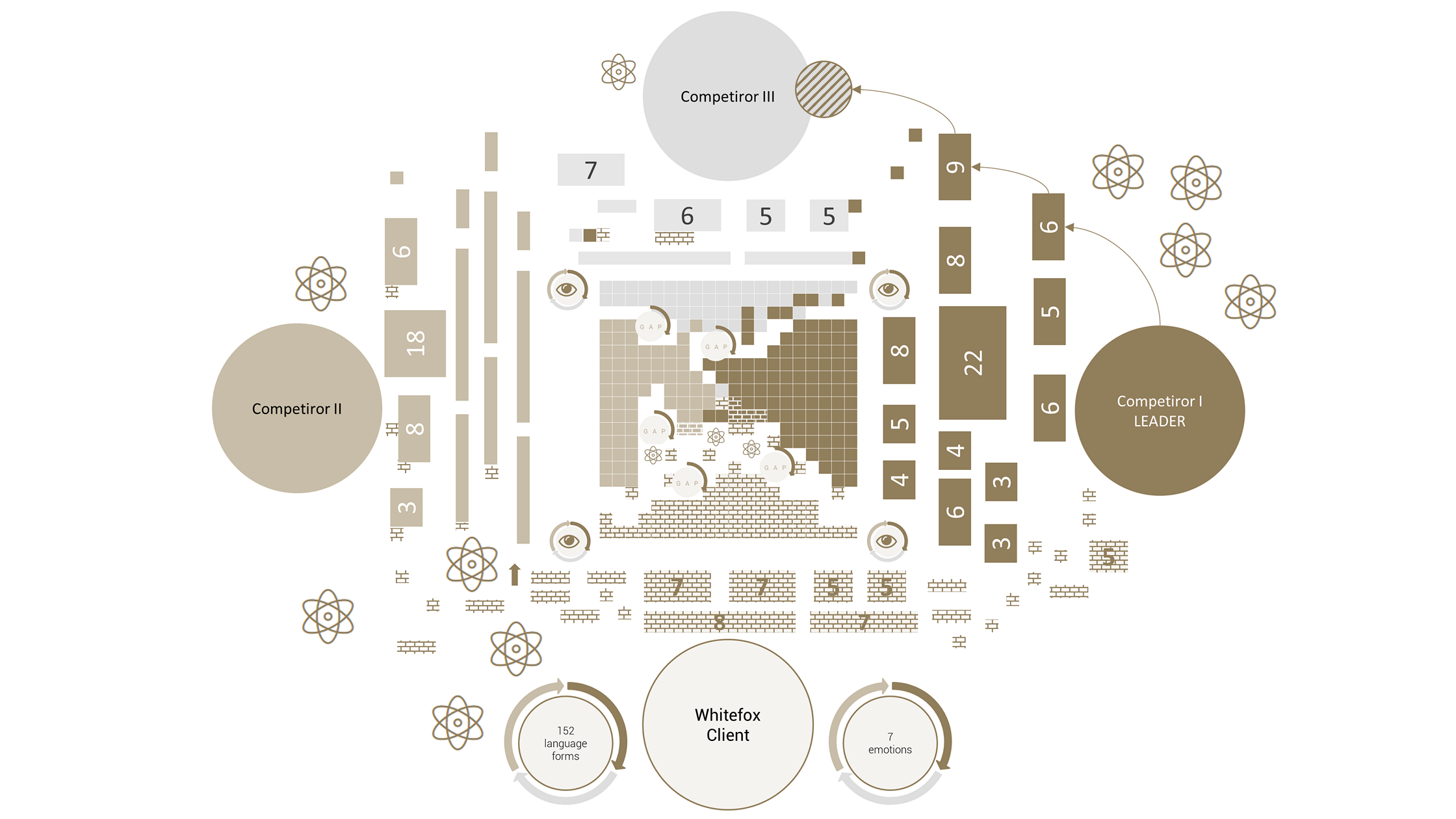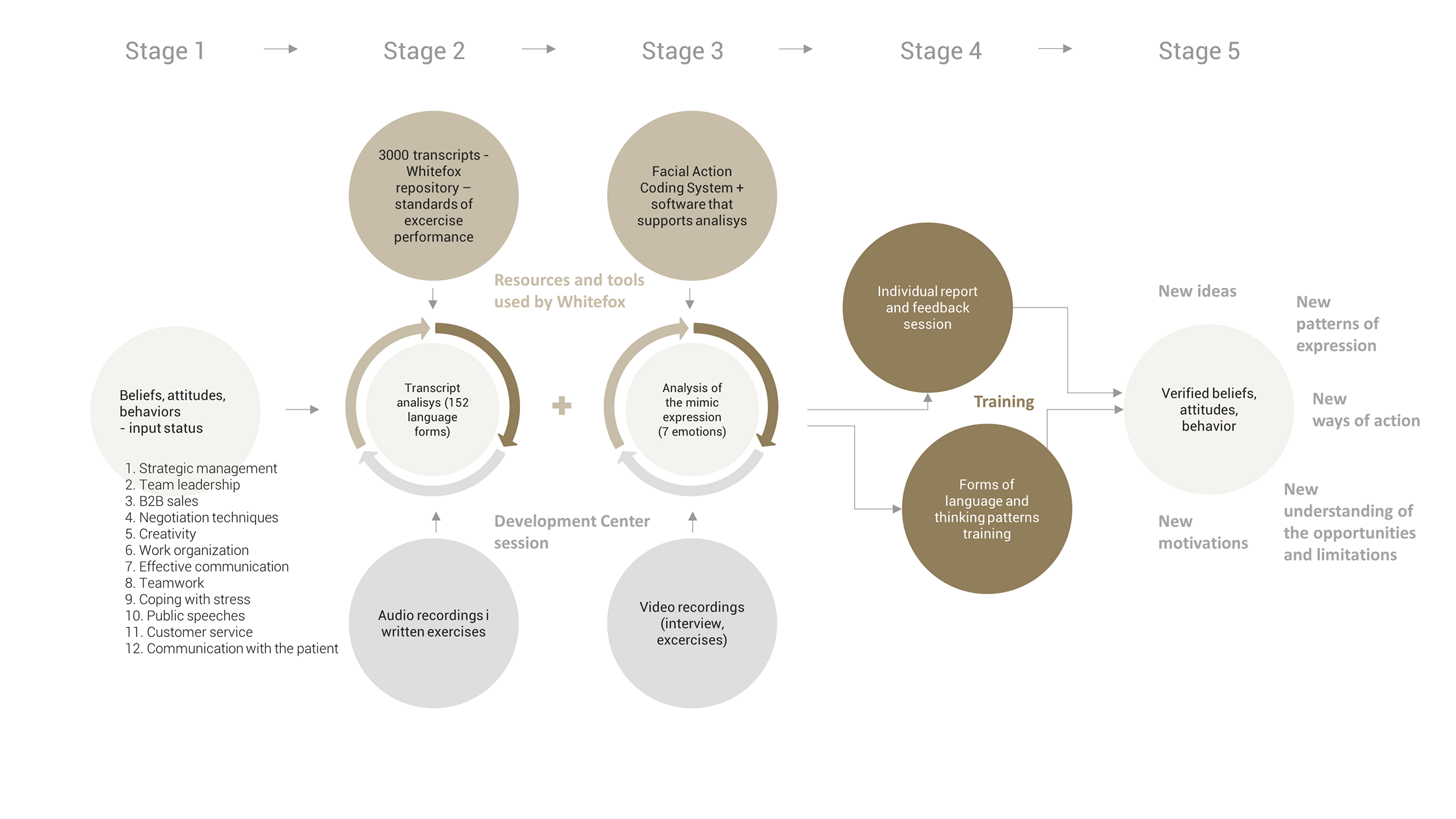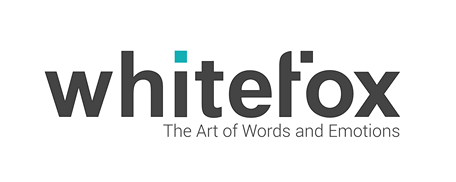Consulting
Markets are conversations
Consulting
motivation and loyalty, trends, segments, managers, systems
Assessment of development opportunities
As a strategic agency, we start the consultancy collaboration from defining the development opportunities that are most important to your company. Most often, we use a pattern that divides development opportunities into three basic bundles of actions:
- Growth through intensification: a. market penetration strategy; b. market development strategy; c. product development strategy,
- Growth through integration, i.e. alliances and acquisitions: a. vertical ones: suppliers, distributors; b. horizontal ones: competition,
- Growth through diversification: new products for new markets.
All consultancy activities we carry out take place in the context of specific development opportunities: by building a communication strategy with the market, a personal strategy or by recommending managers for highest positions in the company, we need to know what is most important for you at the relevant time.
"Markets are conversations” (The Cluetrain Manifesto) - in every development strategy, what we say to our customers and business partners and how we say it is of crucial importance.
Logic of action
An important step in our strategic workshops is to name the logic of action of an enterprise and its individual business units. Referring to leadership models, we distinguish company’s 5 market orientations:
- Production orientation where the high availability of products and services and their low price are most important,
- Product orientation where the emphasis is placed on the high quality, usability and innovation of the solutions offered,
- Sales orientation that is based primarily on the network of business relations and the competencies of salesforce,
- Marketing orientation where needs and emotions of customers become the strategic point of reference,
- 5. Holistic orientation where “everything matters”, and the 5 factors enable to predict the future of the company, namely:
- employee motivation and loyalty,
- favourable trends and calendar of events on the market,
- properly selected territories/segments of competition,
- competencies and wisdom of managers,
- usability and transparency of formal systems and regulations.
If we analyse the situation and see hardly any factors in favour of the success of the company or business unit, we help in restructuring it. When acting against people, in the wrong place and at the wrong time, without market mapping and in chaos, it is impossible to win with the clever, unified and effectively organised competition.
The right selection of methods and tools of change is determined by the discovered current logic of company’s operation.
The ability to decentralise, i.e. to go beyond one’s own needs, thoughts and aspirations, is a prerequisite for understanding company’s strategic communities and market opportunities.
When formulating the first assumptions of the philosophy of language, Ludwig Wittgenstein created the concept of a “logical form”. Analysing what we say and how we do it, he wrote: “A gramophone record, the musical idea, the written notes, and the sound-waves, all stand to one another in the same internal relation of depicting that holds between language and the world. They are all constructed according to a logical pattern”. Our consultancy activities aim, first of all, at the synchronisation of the company with its market, so that products, services, employees’ competencies, organisational culture, and the development and communication strategy are the mapping of the market and the thoughts and needs of customers. By referring to the above quote, the strategic question will be in this situation whether or not today we are ready to design solutions that our customers will expect in a year or two or in the next few years.
An example of market mapping according to the Whitefox model (selected strategic elements):

Dynamics of competition and competition strategies
Moving to the analysis of competition and formulation of the strategy of actions, we most often use the model of an army meeting on a battlefield. Each of the competitors enters different units in the competition. The flagship product that enables to maintain a strategic place in key distribution channels will have a different place in the series than another product which, at the moment, is only a stronghold on a given market or in a given category or product line. The right mapping of competition set-up and its strategic business units allows to take extremely precise and effective tactical actions. During our strategic workshops, we teach how to recognise 9 territories of competition, and we practice and plan dozens of tactical manoeuvres, such as position defence, flanking defence, defence through pre-emptive attack, defence by counter-offensive, mobile defence, strategic retreat, frontal attack, attack on flanks, circling attack, bypass attack, guerrilla attack.
The lack of precise mapping of competition’s position, its strategic business units and currently implemented tactical manoeuvres expose our best ideas and investments to a huge risk.
Project results of Whitefox consulting activities:
- Development and communication strategies:market analysis and decomposition (segments, niches, gaps), product and technology decompositions (R&D analyses), tactical plans for implementing a new product or changing a brand image, communication briefs, development and competition strategies,
- Personnel strategies strategic documents in respect of HR management, including solutions regarding: job descriptions and career paths, recruitment, on-boarding, training and development, periodic assessment, motivation, promotion and talent management, termination of collaboration and dismissal,
- Competency models: competency catalogues, competency profile matrices adjusted to the current corporate strategy, scales for periodic assessments of soft and hard competencies (technical skills, operation of tools, machinery and technology), questions and scales of assessment for recruitment interviews,
- HRM implementation: full implementation of the Whitefox app platform enables the digitalisation of all key personnel processes (see personal strategies),
- Assessment Center: recommendations in the form of collective and/or individual reports regarding the candidates applying for positions and functions strategic for our customers’ companies (managers, directors, management). Whitefox has never headhunted; it does not and will not deal with this kind of activity; at our customers’ request, we participate in recruitment processes for higher positions only as third-party assessors, not being part of any recruitment agency. In the course of our Assessment Centre, we solely use our own assessment tools.
- Development Center: Whitefox individual reports including the analysis of logic of statements and analysis of facial expressions together with detailed development guidelines in respect of language forms and methods of working on patterns of emotional expression that make functioning difficult. Whitefox reports from DC sessions are passed only to the people who participate in a relevant development programme during the feedback session; we never provide them to superiors.
- Periodic assessment: procedures and rules of periodic assessment, observation scales and instructions for use of the assessment form, messages informing about the scope and course of the assessment process,
- 360-degree assessment: profile and pattern of the 360-degree assessment, procedures and rules related to the assessment, observation scales and instructions for individual groups of assessors, templates and models of messages on the scope and course of the assessment,
- AC/DC exercise package: AC/DC exercise catalogue dedicated to the company and adapted to the context of its operation, consisting of the following elements: basket of tasks allowing preparation of different versions of this exercise, simulation exercise x 2, group discussions x 2, negotiation exercise x 2, conversation with team exercise x 2, superior-subordinate exercise x 6, conversation with customer exercise x 4, presentation exercise, creative exercises x 4, behavioural interview in respect of organisation of own work and professional development. We prepare all the exercises and the interview in relation to the standards obtained for traditional AC/DC Whitefox exercises (research sample: 3,000 transcripts of the above-mentioned exercises). The prepared exercises enable to perform a reliable analysis of statements and patterns of facial expressions.
- Competency tests: Tests have been prepared in accordance with the Whitefox Statement Coding System. The task of the examined person is most often the selection of appropriate language forms for the professional situations described in the tests. We use our tests as a complementary exercise during the Development Centre session.
In order to obtain an offer dedicated to your company in respect of the consultancy areas described above, contact us on (58 739 63 31) or by email (biuro@whitefox.pl).
Training and devlopment
Manager development programme
Training and development
models of adult human development, stages and crises
12 topical areas
Whitefox provides 12 basic training courses. Each of them is a topical area that includes broad and diverse knowledge, skills and technologies from a given field. For each of the topics, we have selected methods and exercises whose effectiveness has been reliably verified in empirical research and business practice. We only choose those solutions whose results can be measured and precisely quantified.
The Statement Coding System and the facial expression coding system "translates our customers’ thoughts and emotions into mathematics” which changes their understanding of themselves, of others and of the world in which they pursue their business.
Mindfulness and accuracy
The promise we make to you is that we will, in all our development activities, maintain the maximum precision and mindfulness. In our opinion, the majority of adults change their beliefs, attitudes and behaviours in a situation where results of the adopted logic of action involve losses, failures and problems. However, connecting the style of action with its inherent consequences requires precise and quantified feedback. Otherwise, it is not clear which results from which.
„We count words, statements and grammatical structures; we count face movements” - the knowledge that we derive from this experience helps our customers achieve important development and business goals.
Development programmes
Our core activity is the implementation of complex development programmes. We start collaboration from the definition of competency profile that will be verified and developed during the programme. Next, we carry out the Development Centre sessions, so that each participant can obtain an individual report with the record of key forms of statements and preferred emotional reactions. After completion of the feedback session, we move to behaviour training. Individual reports are only provided to the people concerned. A summary report is anonymous and prevents identification of individual employees.
Below, we present one of the development patterns we use. The subject of improvement can be any skills of the 12 topical areas. In a situation where the study group operates in a unique context that prevents the use of standard Whitefox scales and exercises, the entire programme and all tools are adapted to the specific circumstances of operation of individual persons.
A sample Whitefox development programme pattern:

From paraphrase to Heisenberg’s matrix mechanics
During performed development activities, we teach the simplest things, such as asking open questions or paraphrasing statements of others. These skills, although technically not causing any difficulty to anyone (everyone can ask a question with what, how, when, where, and almost everyone can repeat what he/she has just heard), require special mindfulness and training in practice. In order to deal with the mind that “thinks too much” or “works too much”, we are forced to refer to models, theories and abstractions.
Building the motivation to listen and learn results from going beyond what we take for granted and see as obvious.
At the beginning, many rejected the Heisenberg’s matrix mechanics: it assumed something disturbing, something that exceeded the imagination, something that was destroying foundations. What does reality mean where there is no “place” of which we can become cognisant? What “is” the world which we can enter by means of numbers and equations? How can there “not be” something as obvious as 3D space that permeates almost every concept we use?
Some of the participants of our training courses constantly talk and interrupt others or stubbornly keep silent or control everything around until they deal with their basic assumptions. Whitefox specialises in working with people who know too much or work too much, although they are not necessarily worried about Heisenberg’s findings.
In order to obtain a training or development programme offer dedicated to your company, contact us on (58 739 63 31) or by email (biuro@whitefox.pl).
